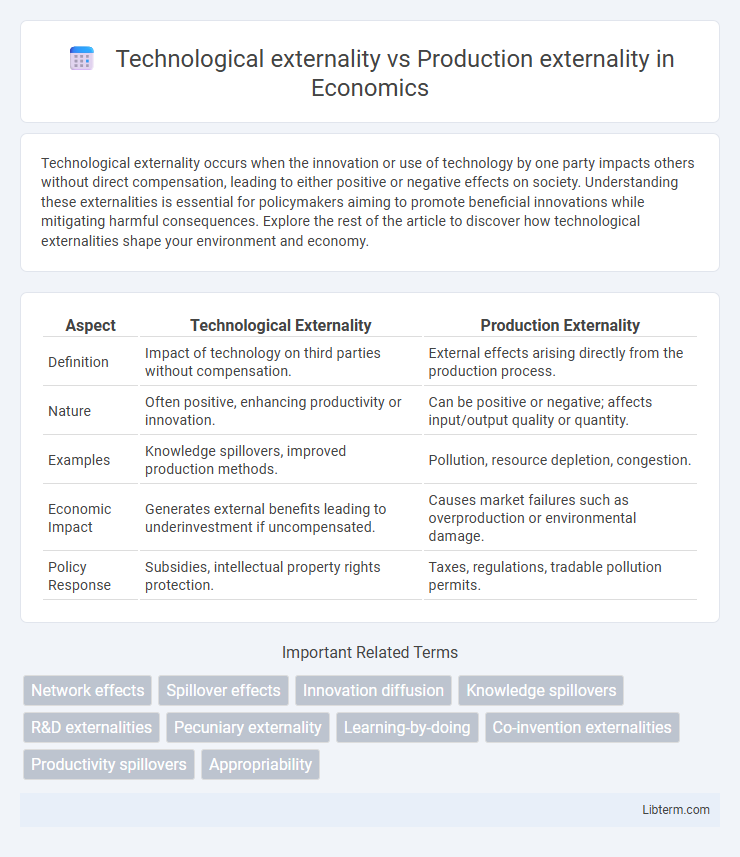Technological externality occurs when the innovation or use of technology by one party impacts others without direct compensation, leading to either positive or negative effects on society. Understanding these externalities is essential for policymakers aiming to promote beneficial innovations while mitigating harmful consequences. Explore the rest of the article to discover how technological externalities shape your environment and economy.
Table of Comparison
| Aspect | Technological Externality | Production Externality |
|---|---|---|
| Definition | Impact of technology on third parties without compensation. | External effects arising directly from the production process. |
| Nature | Often positive, enhancing productivity or innovation. | Can be positive or negative; affects input/output quality or quantity. |
| Examples | Knowledge spillovers, improved production methods. | Pollution, resource depletion, congestion. |
| Economic Impact | Generates external benefits leading to underinvestment if uncompensated. | Causes market failures such as overproduction or environmental damage. |
| Policy Response | Subsidies, intellectual property rights protection. | Taxes, regulations, tradable pollution permits. |
Introduction to Externalities
Technological externality occurs when the technology used by a firm or individual impacts others without compensation, such as pollution affecting nearby residents. Production externality specifically refers to external effects arising from the production process, for example, a factory emitting waste that harms the environment. Both types of externalities represent market failures where private costs or benefits differ from social costs or benefits, highlighting the need for regulation or intervention.
Defining Technological Externality
Technological externality occurs when a firm's technology choices impact the production capabilities or costs of other firms without compensation, influencing overall market efficiency. This form of externality differs from production externality, which arises from the direct allocation of resources or outputs rather than technology use. Understanding technological externalities is crucial for assessing innovation spillovers and designing policies to encourage positive technological diffusion.
Defining Production Externality
Production externality occurs when a firm's production activities directly affect the production capabilities or costs of other firms without compensation, leading to market inefficiencies. This external effect can be either positive, such as knowledge spillovers enhancing productivity, or negative, like pollution increasing costs for neighboring producers. Technological externality relates more broadly to how technology changes impact other firms or sectors, often driving production externalities through innovation diffusion or environmental effects.
Key Differences Between Technological and Production Externalities
Technological externalities occur when the production or consumption of a good directly affects third parties through changes in technology or knowledge without involving market transactions. Production externalities arise specifically from the production process, impacting third parties via external costs or benefits such as pollution or enhanced productivity. The key difference lies in their source: technological externalities stem from innovation and knowledge spillovers, while production externalities result from external effects generated during the physical production activities.
Sources of Technological Externalities
Technological externalities arise when the innovation or knowledge generated by one firm or individual benefits others without direct compensation, often through spillovers in research and development or improved production techniques. These sources include knowledge diffusion, where new technologies become accessible beyond the original creator, and network effects, which enhance the value of technology as more users adopt it. In contrast, production externalities relate specifically to the unintended side effects of the production process, such as pollution or resource depletion, impacting third parties directly.
Sources of Production Externalities
Production externalities arise when a firm's production activities impose positive or negative effects on other producers or society without compensation. Technological externalities are a primary source, occurring when innovations or improvements in production processes spill over, benefiting or harming other firms by enhancing efficiency or causing pollution. Other sources include resource depletion, congestion effects, and shared infrastructure usage, which alter production costs or outputs beyond the originating firm's control.
Impact on Social Welfare and Efficiency
Technological externalities, stemming from innovations or knowledge spillovers, enhance social welfare by generating widespread benefits without additional resource use, thus improving overall efficiency in production. Production externalities occur when a firm's output affects third parties positively or negatively, causing market failures that reduce social welfare and create inefficiencies unless corrected by interventions like taxes or subsidies. Effective internalization of both externalities is crucial for aligning private incentives with social optimality, optimizing resource allocation, and maximizing economic efficiency.
Real-World Examples of Technological Externalities
Technological externalities occur when innovations or technological advancements impact third parties without direct compensation, such as the widespread adoption of the internet enabling global communication but also raising cybersecurity risks. Production externalities arise during the manufacturing process, exemplified by factories emitting pollution that harms local communities' health and environment. Notable real-world technological externalities include the invention of GPS technology improving navigation globally while exposing users to privacy concerns through location tracking.
Real-World Examples of Production Externalities
Production externalities occur when a firm's output affects third parties without compensation, often leading to market inefficiencies. Real-world examples include industrial factories emitting pollution that harms nearby residents' health and reduces property values, or agricultural activities causing nutrient runoff that contaminates water bodies and disrupts aquatic ecosystems. These negative externalities prompt governments to implement regulations or taxes to internalize social costs and improve resource allocation.
Policy Solutions and Management Strategies
Technological externalities involve unintended effects of innovation influencing third parties and require policies that promote research incentives, patent regulations, and knowledge-sharing frameworks to encourage positive spillovers while managing negative impacts. Production externalities arise from industrial activities causing environmental or social costs not reflected in market prices, necessitating regulatory measures such as pollution taxes, emission trading schemes, and mandatory environmental standards to internalize these external costs. Effective management strategies integrate stakeholder engagement, continuous monitoring, and adaptive governance to align economic activities with sustainable development goals and mitigate externality-related inefficiencies.
Technological externality Infographic

 libterm.com
libterm.com